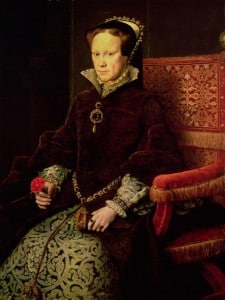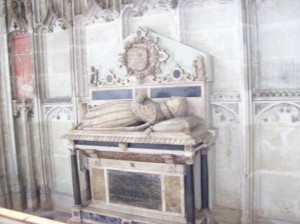 On 19th July 1553, thirteen days after the death of her half-brother, Edward VI, Mary was proclaimed Queen in place of Queen Jane.
On 19th July 1553, thirteen days after the death of her half-brother, Edward VI, Mary was proclaimed Queen in place of Queen Jane.
The Earls of Pembroke and Arundel had called a council meeting the previous day to convince council members that Mary’s claim to the throne was legitimate, but it was on this day in 1553 that they managed to convince the remaining privy councillors to switch sides from Jane to Mary. Their strategy was not just gentle persuasion, Pembroke actually drew his sword and cried, “If the arguments of my lord Arundel do not persuade you, this sword shall make Mary queen, or I will die in her quarrel.” Of course, everyone agreed with his arguments.
Pembroke announced Mary’s accession to the people of London that afternoon:
“The xix. day of the same monyth, [which] was sent Margarettes evyne, at iiij. of clocke at after-none was proclamyd lady Ma[ry to] be qwene of Ynglond at the crose in Cheppe with the erle of Shrewsbery, the earle [of Arundel], the erle of Pembroke, with the mayer of London, and dyvers other lordes, and many of the ald[dermen] and the kynges schrffe master Garrand, with dyvers haroldes and trompettes. And from thens cam to Powlles alle, and there the qwere sange Te Deum with the organs goynge, with the belles ryngynge, the most parte alle [London], and that same nyght had the [most] parte of London Te Deum, with bone-fyers in every strete in London, with good chere at every bone [fyer], the belles ryngynge in every parych cherch, and for the most parte alle nyght tyll the nexte daye to none.”
It seems that London was happy with the news.
Back at the Tower of London, Lady Jane Grey’s father, the Duke of Suffolk, interrupted his daughter’s evening meal to inform her that she was no longer Queen. Her canopy of state was taken down and Lady Jane Grey turned from Queen to prisoner, Queen to traitor. Her reign was over, and she would go down in history as “the Nine Day Queen”, although officially she reigned for thirteen days.
Mary didn’t actually know that she had been proclaimed Queen at this point. She found out the next day when William Paget and the Earl of Arundel arrived at Framlingham with the news.
(Taken from “On This Day in Tudor History” by Claire Ridgway)
Also on this day in history…
- 1543 – Death of Mary Stafford (née Boleyn), other married name Carey. It is not known where she was buried and there is also controversy regarding her date of death.
- 1545 – Henry VIII’s flagship, the Mary Rose, sank right in front of his eyes in the Battle of the Solent between the English and French fleets. Read more at 19 July 1545 – The Sinking of the Mary Rose.
- 1584 – Death of three year-old Robert Dudley, Baron Denbigh, son of Robert Dudley, Earl of Leicester, and his wife, Lettice, at Wanstead. He was laid to rest in the Beauchamp Chapel of St Mary’s Church, Warwick, and his tomb pays tribute to “the noble imp”.
